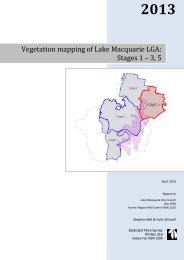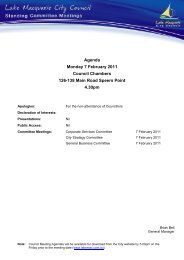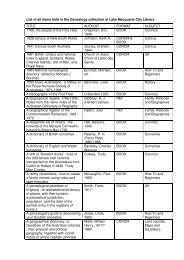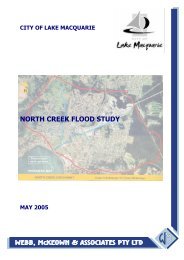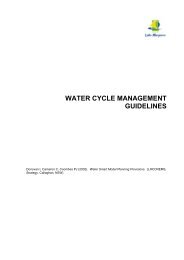A Guide to Disability Awareness and Communication - Lake ...
A Guide to Disability Awareness and Communication - Lake ...
A Guide to Disability Awareness and Communication - Lake ...
You also want an ePaper? Increase the reach of your titles
YUMPU automatically turns print PDFs into web optimized ePapers that Google loves.
A <strong>Guide</strong> <strong>to</strong> <strong>Disability</strong><strong>Awareness</strong> <strong>and</strong> <strong>Communication</strong>
A <strong>Guide</strong> <strong>to</strong> <strong>Disability</strong> <strong>Awareness</strong> <strong>and</strong> <strong>Communication</strong>__________________________________________________________________________Underst<strong>and</strong>ing <strong>Disability</strong>How would you face the challenge of not being able <strong>to</strong> carry out basic everyday living tasks?We all have days where nothing seems <strong>to</strong> go right, where barriers obstruct even simpleactivities. For people with a disability, they face barriers every day, in accessing facilities <strong>and</strong>services such as shopping, transport <strong>and</strong> entertainment.• It is estimated that 16.9% of the Australian population has a disability, which restrictsthem in carrying out basic everyday living tasks (<strong>Disability</strong>, Ageing <strong>and</strong> Carers, 1998– ABS). In the City of <strong>Lake</strong> Macquarie, approximately 30,927 people are affected.• The incidence of disability also increases with age. In the City of <strong>Lake</strong> Macquarie25.44% of the population are aged 55 years <strong>and</strong> over (ABS Census 2001).As people with a disability make up a significant proportion of our population, there is a needfor Council staff <strong>to</strong> underst<strong>and</strong> how <strong>to</strong> relate <strong>to</strong> people with a range of disabilities. Councilwill also need <strong>to</strong> modify some of its delivered services, <strong>and</strong> provide additional infrastructure<strong>to</strong> meet the needs of an ageing population.The following information on types of disability <strong>and</strong> the communication guides should assistyou not only <strong>to</strong> provide services <strong>to</strong> Council’s cus<strong>to</strong>mers, but will also assist you <strong>to</strong> interactwith friends, family members <strong>and</strong> people generally.<strong>Disability</strong> DiscriminationThe Commonwealth <strong>Disability</strong> Discrimination Act (DDA) provides protection for everyone inAustralia against discrimination based on disability. The Act also means meetingresponsibilities that many people may not be aware of. It encourages everyone <strong>to</strong> beinvolved in implementing the Act <strong>and</strong> <strong>to</strong> share in the benefits people with a disability canmake <strong>to</strong> the community <strong>and</strong> the economy.<strong>Disability</strong> discrimination happens when people with a disability, are treated less fairly thanpeople without a disability. It also occurs when people are treated less fairly because theyare relatives, friends, carers, co workers or associates of a person with a disability. Types ofdisabilities covered under the DDA include physical, intellectual, psychiatric, sensory,neurological <strong>and</strong> learning disabilities as well as physical disfigurement <strong>and</strong> the presence inthe body of disease causing organisms.The DDA makes it unlawful <strong>to</strong> discriminate against a person with a disability in the followingareas of life:• employment <strong>and</strong>/or education• access <strong>to</strong> premises/places used by the public eg public footpaths, theatres, libraries,restaurants, swimming pools• provision of goods, services <strong>and</strong> facilities eg public transport, sporting facilities• buying l<strong>and</strong> or providing accommodation• sport <strong>and</strong>/or activities of clubs <strong>and</strong> associations• administration of Commonwealth Government laws <strong>and</strong> programs.Further information on the DDA is available:• by telephoning the Human Rights <strong>and</strong> Equal Opportunities Commission – 1300 369 711• or at www.hreoc.gov.au/disability_rights/index.html3
A <strong>Guide</strong> <strong>to</strong> <strong>Disability</strong> <strong>Awareness</strong> <strong>and</strong> <strong>Communication</strong>__________________________________________________________________________<strong>Guide</strong> <strong>to</strong> Communicating with People who have a <strong>Disability</strong>General Information:• First <strong>and</strong> foremost, people with a disability, are people. Treat everyone the wayyou would wish <strong>to</strong> be treated.• Secondly, people with a disability have a condition, which may limit their mobility,hearing, vision, speech or mental function. They may also use mobility,communication <strong>and</strong> other aids <strong>to</strong> assist them carry out every day living tasks.• People with a disability are not conditions or diseases. Rather than, ”he is anepileptic”, “he is a person with epilepsy”.• When introduced <strong>to</strong> a person with a disability it is appropriate <strong>to</strong> offer <strong>to</strong> shakeh<strong>and</strong>s. People with limited h<strong>and</strong> use, or who wear an artificial limb, can usuallyshake h<strong>and</strong>s. If a person indicates that they are unable <strong>to</strong> shake h<strong>and</strong>s a verbalacknowledge should be given <strong>to</strong> acknowledge their presence.• When talking <strong>to</strong> a person with a disability use a normal <strong>to</strong>ne of voice, look at <strong>and</strong>speak directly <strong>to</strong> that person rather than through a companion or aide who may bewith them.• It is important <strong>to</strong> be relaxed <strong>and</strong> open in your communication. Don't beembarrassed, treat a person with a disability as you would any other cus<strong>to</strong>mer.• Relax, don’t be embarrassed if you happen <strong>to</strong> use common expressions such as“see you later” or “got <strong>to</strong> be running along”, that seem <strong>to</strong> relate <strong>to</strong> a person’sdisability• Never assume a person needs assistance. You may offer assistance with dignity<strong>and</strong> respect, but be prepared <strong>to</strong> have your offer declined.• Underst<strong>and</strong> that access <strong>to</strong> the services at Council includes not only physicalaccess. It could also include making written, tactile, or audio materials accessible<strong>to</strong> people with visual or cognitive disabilities <strong>and</strong> making visual materials or othersignals accessible <strong>to</strong> people with hearing impairment.• Be aware that often people may have hidden disabilities, such as people withacquired brain injury, learning difficulties or other forms of cognitive impairment.Other disabilities such as back injuries, respira<strong>to</strong>ry/cardiac diseases are also notalways obvious.• Children are naturally curious, so allow them <strong>to</strong> ask questions about a person witha disability, or a person’s wheelchair or other aids. Open communication helpsovercome fearful or negative attitudes.People with a Vision Impairment• When greeting a person with a severe loss of vision, always identify yourself <strong>and</strong>others who may be with you eg “my name is John Smith <strong>and</strong> on my right is MaryJones.”• When conversing in a group, give a vocal cue by announcing the name of theperson <strong>to</strong> whom you are speaking eg “Mary, what do you think about theprocess.”• Speak in a normal <strong>to</strong>ne of voice, indicate in advance when you will be movingfrom one place <strong>to</strong> another <strong>and</strong> let it be known when the conversation is at an end.• Offer a person with visual impairment the opportunity <strong>to</strong> take your arm (at or about4
A <strong>Guide</strong> <strong>to</strong> <strong>Disability</strong> <strong>Awareness</strong> <strong>and</strong> <strong>Communication</strong>__________________________________________________________________________the elbow), this enables you <strong>to</strong> guide them rather than propel or lead them.People with a Hearing Impairment• When communicating with a person with a hearing impairment, look directly at theperson <strong>and</strong> speak clearly, naturally <strong>and</strong> slowly.• Not all people with a hearing impairment can lip read. People, who can lip read,will rely on facial expression <strong>and</strong> other body language <strong>to</strong> help in underst<strong>and</strong>ing.• Do not shout at a person with a hearing impairment. Shouting dis<strong>to</strong>rts soundsaccepted through hearing aids <strong>and</strong> inhibits lip reading.• Show consideration by placing yourself facing the light source <strong>and</strong> keeping yourh<strong>and</strong>s, cigarettes <strong>and</strong> food away from your mouth when speaking.• Written notes may aid conversations with person with a hearing impairment.• To facilitate conversation, be prepared <strong>to</strong> offer a visual cue <strong>to</strong> a person with ahearing impairment.People who use Mobility Aids:• When addressing a person who uses a wheelchair, don’t lean on it, rock or movetheir chair. The wheelchair is part of their personal body space.• If a person has transferred out of their chair, do not move it out of reach.• People who use canes, crutches or other mobility aids may also regard them aspart of their personal space, so unless the individual requests your assistance, donot offer <strong>to</strong> h<strong>and</strong> cane or crutches.• Offer a person who uses mobility aids such as walkers or crutches a seat if youare going <strong>to</strong> be speaking <strong>to</strong> them for more than a minute.• When talking with a person in a wheelchair for more than a few minutes, use achair, whenever possible, in order <strong>to</strong> place yourself at the person's eye level <strong>to</strong>facilitate conversation.• Never patronise people using wheelchairs by patting them on the head orshoulder.People with a Speech Impairment• Listen attentively when you're talking <strong>to</strong> a person who has a speech impairment.Keep your manner encouraging rather than correcting.• Exercise patience rather than attempting <strong>to</strong> speak for a person with speechdifficulty. When necessary, ask short questions that require short answers or anod or a shake of the head.• Never pretend <strong>to</strong> underst<strong>and</strong> if you are having difficulty doing so. Repeat whatyou underst<strong>and</strong>, or incorporate the statements in<strong>to</strong> each of your followingquestions. The person's reactions will clue you in <strong>and</strong> guide you <strong>to</strong>underst<strong>and</strong>ing.• If you have difficulty communicating, be willing <strong>to</strong> repeat or rephrase a question.5
A <strong>Guide</strong> <strong>to</strong> <strong>Disability</strong> <strong>Awareness</strong> <strong>and</strong> <strong>Communication</strong>__________________________________________________________________________People with a Cognitive or Mental Health <strong>Disability</strong>• You can’t tell by looking at someone if they have a mental health disability.• 1 in 5 Australians have had, or will have a mental health disability in their lifetime. Mental health conditions include depression, anxiety, psychosis <strong>and</strong>dementia.• Cognitive disabilities can be caused by a stroke or degenerative diseases.• People with cognitive or mental health disabilities frequently find it difficult <strong>to</strong>ask for assistance. They may sometimes present with a minor request that isnot their major issue of concern.• Be attentive <strong>and</strong> show respect. Don’t draw attention <strong>to</strong> unusual behaviour infront of others.• Make sure that your verbal <strong>and</strong> non verbal communications are consistent.More information available at www.mentalhealth.gov.auTelephone technique for dealing with a person with a disabilityWhen dealing with a person over the telephone there are no non verbalcommunication clues. Barriers <strong>to</strong> communication, not obvious at your end of theconversation, may also be present.Therefore, it is not possible <strong>to</strong> know if a person has a disability unless they tell you.General communication principles apply:• Listen carefully <strong>to</strong> the request or complaint• If you don’t underst<strong>and</strong> what the cus<strong>to</strong>mer has said, don’t pretend <strong>to</strong>underst<strong>and</strong>.• Ask questions <strong>to</strong> clarify your underst<strong>and</strong>ing of the information provided by thecus<strong>to</strong>mer.• Affirm what you have heard.• Provide information in response <strong>to</strong> the request or complaint.• Clarify the cus<strong>to</strong>mer’s underst<strong>and</strong>ing of the information you have provided.• Never record information about a person’s disability unless they have givenyou permission <strong>to</strong> do so, <strong>and</strong> it relates directly <strong>to</strong> their request or serviceprovision.6
A <strong>Guide</strong> <strong>to</strong> <strong>Disability</strong> <strong>Awareness</strong> <strong>and</strong> <strong>Communication</strong>__________________________________________________________________________Information on Aids <strong>to</strong> Assist People with a Hearing Impairment.Telephone Typewriters (TTY's)TTY's enable text communication over the telephone line between two people, one orboth of whom may be deaf. The typed message appears on a display panel <strong>and</strong>, onsome machines, as a printed message.Telephone AidsMany of the newest telephones, including Telstra's Touch<strong>to</strong>ne 400, have a built inhearing aid coupler <strong>and</strong>, when used with a "T" switch of a hearing aid, will reducebackground noise.Some telephone aids such as visual signalling devices, <strong>to</strong>ne ringers <strong>and</strong> gliding <strong>to</strong>necallers are available <strong>to</strong> eligible persons, from Telstra, free of charge. For furtherinformation contact your nearest Telstra office. External couplers are also available.National Relay Service (NRS)The NRS is available <strong>to</strong> people who are deaf or have a hearing loss, <strong>and</strong> thosepeople who have a speech impairment. The service facilitates telephoneconversation between a person with a TTY or computer modem, <strong>and</strong> a person usingan ordinary telephone.The NRS number is 133 677 <strong>and</strong> the service is available 24 hours a day, 7 days aweek.For more information: Freecall TTY: 1800 555 630 or Freecall voice: 1800 555 660 orFax: 1800 555 690.Assistive Listening SystemsDevices <strong>to</strong> aid listening operate by excluding background noise <strong>and</strong> providingindividual volume control. They are helpful in listening <strong>to</strong> the radio or television, <strong>and</strong>in public buildings where public address systems are installed.Some public buildings such as churches, theatres, concert halls etc. have assistivelistening systems. The following systems are available:Audio Loop: People wearing hearing aids with a "T" switch can tune in<strong>to</strong> theelectromagnetic field generated by an audio loop that is attached <strong>to</strong> a microphone orsound source.Infra Red System: Sound can be transmitted as infra red light waves. A transmitteris attached <strong>to</strong> the sound source <strong>and</strong> a receiver worn <strong>to</strong> pick up the sound.FM System: Sound is transmitted as FM radio waves from a speaker, using atransmitter, <strong>to</strong> the listener wearing a receiver. This system is used in classrooms <strong>and</strong>for lecture <strong>to</strong>urs.7
A <strong>Guide</strong> <strong>to</strong> <strong>Disability</strong> <strong>Awareness</strong> <strong>and</strong> <strong>Communication</strong>__________________________________________________________________________There are many other aids <strong>and</strong> devices available including:Flashing Lights - these can be attached <strong>to</strong> your door bell, telephone, alarmclock or baby cry alarm.Vibrating Alarm Clocks <strong>and</strong> Discs - these are placed under the pillow <strong>and</strong>vibrate rather than give out an audible sound.Hearing Dogs – these specially trained dogs alert their owners <strong>to</strong> a variety ofsounds including a baby's cry, a door bell or <strong>to</strong> warn of danger.8



